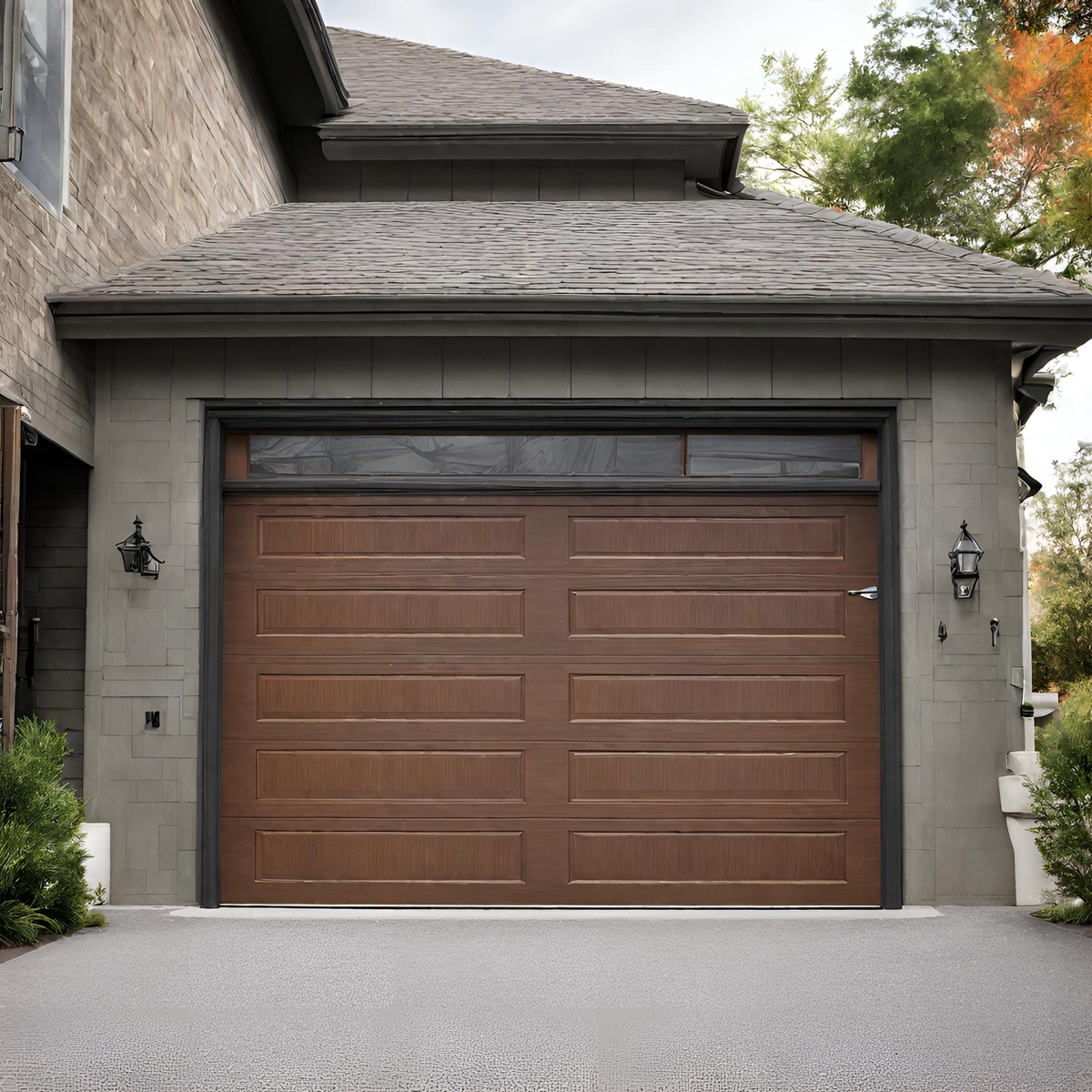Installing a new garage door or repairing an existing one requires having the right parts and supplies on hand. When it comes to garage door supply, you have many options to consider. In this guide, we’ll walk you through the key components of a garage door system and provide tips on choosing the right parts and hardware for your needs.
I. The Main Components of a Garage Door
A basic garage door assembly consists of several main components:
-
The door panels - These typically come in steel, aluminum, fiberglass, or wood. The panels connect together to form the overall door surface.
-
Tracks - These metal tracks guide the rollers on the door and allow it to move up and down. Tracks are mounted to the walls along the top and sides of the garage doorway.
-
Rollers - These wheels attach to the door panels and roll up and down within the metal tracks as the door opens and closes. Nylon rollers provide quiet operation.
-
Spring Assembly - Torsion springs mounted on a metal shaft provide lifting power to counterbalance the weight of the garage door. Extension springs stretch and retract to assist opening and closing.
-
Cables - These connect the garage door to the counterbalance spring mechanism. The cables help lift the weight of the door.
-
Hinges - Hinges connect each of the door sections together so they can fold up accordion style as the door opens.
-
Rollers - Rollers fitted inside the hinges allow the door panels to roll along the tracks.
-
Track Hardware - Plates, brackets, hanger brackets, and other hardware secure the tracks to the framing around the garage door opening.
-
Struts & Reinforcement - Strutting across the back of the door adds stability and reinforcement across large door panels.
-
Weatherstripping - Vinyl, rubber, felt, or brush strips seal the gaps around a garage door to block dust and weather.
-
Bottom Seal - This T-shaped rubber seal attaches along the door bottom to seal the gap between the door and floor.
Knowing the purpose of each garage door component will help guide you in selecting the right replacement parts.
II. Choosing the Right Garage Door Materials
When selecting a new garage door, you can choose from several budget-friendly options:
-
Steel - Steel garage doors are the most affordable option. They offer good durability and energy efficiency. Galvanized steel resists rust and dents.
-
Aluminum - Aluminum doors are lightweight, rust-resistant, and dent-proof. More expensive than steel but require less maintenance.
-
Fiberglass - Fiberglass doors mimic the look of real wood but don’t warp or rot. They have good insulation value and resist impacts.
-
Wood - Wood doors provide a classic, natural look and good insulation. However, they require regular staining or sealing to prevent damage.
For garage door parts and hardware, common material choices include:
-
Steel - Used for tracks, springs, rollers, cables, and reinforcement. Choose galvanized steel for its durability.
-
Aluminum - Lightweight but strong, aluminum works for tracks, hinges, rollers, and door frames.
-
Nylon - Provides smooth, quiet operation when used for rollers and bushings.
-
Vinyl - Flexible vinyl makes excellent weatherstripping and bottom door seals.
Consider how much use the garage door will get, along with your budget, when selecting materials. Choose galvanized steel or aluminum for high-traffic doors that need increased impact resistance and durability. For lightly used doors in protected areas, affordable steel provides reliable service.
III. Measuring and Sizing Replacement Parts
When ordering replacements, having the right measurements ensures proper sizing and fit. Some key dimensions needed:
-
Overall door size - Measure the height and width to size replacement door panels. Include the track clearance when measuring height.
-
Track length - Measure the vertical and horizontal tracks from end to end. Check measurements on both sides.
-
Curved track radius - Radius dimensions are needed for curved track sections. Measure the curve radius precisely.
-
Torsion spring diameter and length - Measure the active coil diameter and overall spring length.
-
Extension spring diameter and length - For extension springs, measure both the wire diameter and full extended length.
Having these measurements on hand will allow you to order correctly sized parts for proper door operation and balance. For help determining measurements, consult your owner’s manual or contact the door manufacturer.
IV. Choosing Durable Garage Door Hardware
The hardware used for tracks, rollers, cables, hinges, and handles endures constant opening and closing forces over time. Using heavy-duty hardware ensures smooth operation and long-term reliability. When selecting hardware:
-
For tracks and track hardware, choose minimum 14 gauge galvanized steel for strength and corrosion resistance.
-
Nylon track rollers with steel ball bearings provide the smoothest operation. Choose solid steel or zinc coated rollers for high-traffic doors.
-
Aircraft quality cables 1/8" or 3/32" in diameter ensure safe door operation with minimal stretching.
-
Heavy-duty galvanized steel hinges between door sections allow for smooth folding motion.
-
Commercial grade wide style hinges reinforce extra tall doors.
-
Sturdy die cast handles in zinc, chrome, or powder coated finishes provide secure lifting points.
Reinforce larger doors with strut supports across the door panels. For added security, choose latch hardware with keyless entry or encrypted codes. Using rugged professional grade hardware ensures reliable performance season after season.
V. Choosing Insulated Doors for Energy Efficiency
Well-insulated garage doors with weatherstripping and proper seals help keep garages comfortable and utility costs down. For energy efficiency:
-
Steel doors with a baked on finish, polyurethane, or vinyl backing provide thermal insulation.
-
Foam insulated aluminum doors also resist heat flow while blocking noise.
-
Fiberglass and wood doors have inherently good insulation properties.
-
Flexible vinyl, rubber, and felt weatherstripping prevents air infiltration around the door.
-
Bottom door seals made of thick rubber or vinyl seal out drafts along the floor.
-
Plastic retainer and side seals fill gaps along the tracks and edges.
Also ensure the garage door opener has an automatic closing feature. This will reclose the door after use to maintain the insulated seal. Proper insulation and sealing provides comfort and saves energy.
VI. Safety and Security Features
Incorporate safety and security enhancements into your garage door system. Recommended features include:
-
Pinch-resistant door panels that push fingers out of harm's way if contacted while closing.
-
Light beam sensors that detect objects in the path and reverse the closing door.
-
Auto-reverse mechanisms to stop and reverse if a door encounters an obstruction while opening or closing.
-
Breakaway bottom brackets that detach when hit to avoid damage.
-
Quick release mechanisms to disconnect the door if the cable breaks.
-
Encrypted remote controls prevent interference from openers in nearby garages.
-
Built-in locking mechanisms for extra security.
By selecting garage door parts with integrated safety options, you can protect family members, pets, and vehicles.
VII. Choosing Durable and Reliable Springs
Torsion and extension springs help lift the weight of garage doors, allowing for smooth operation. The springs counterbalance approximately 70-80% of the overall door weight. As the most labor-intensive part to replace, durable springs provide reliable long-term service.
High carbon hardened steel springs maintain their tension and resist breaking. Look for springs tested to:
-
10,000 to 30,000 open/close cycles.
-
Meet criteria for ANSI/DASMA 102 standards for durability.
-
Carry a manufacturer’s warranty up to lifetime for breakage.
Choose galvanized springs for corrosion resistance. For high-traffic doors, select springs at the higher tension capacity to handle frequent use without fatigue. With sturdy springs properly matched to your door’s size and weight, the door assembly will enjoy years of trouble-free operation.
VIII. Choosing Aesthetic Accents and Accessories
While garage door parts serve practical functions, decorative accents create attractive curb appeal:
-
Window inserts with clear acrylic panels or decorative glass allow natural light into the garage.
-
Carriage house style doors with decorative hardware and windows lend rustic elegance.
-
Molding trim kits accent door panels, adding depth and visual interest.
-
Custom wood finishes, plank detailing, or faux wood grain mimic natural wood on steel doors.
-
Arched door designs complement homes with arched windows and detailing.
-
Wrought iron hardware and handles infuse vintage charm.
-
Custom color finishes on door panels match the home’s exterior color scheme.
For functionality, add side pass doors for convenient entry, magnetic door seals for tight weatherproofing, and motion detectors for automatic light activation when entering the garage. By selecting stylish design options, hardware, and accessories, your garage door becomes both beautiful and functional.
IX. Finding the Right Garage Door Parts Supplier
Whether you’re repairing, upgrading, or installing new garage doors, it’s helpful to have a knowledgeable supplier. Seek a company that:
-
Provides all components for complete garage door systems.
-
Carries parts from all major manufacturers.
-
Employs experts to assist with product selections.
-
Offers speedy shipping right to your door.
-
Provides instructional videos and tutorials for DIY repairs.
To Sum Up
We hope this garage door supply guide provides helpful insights on selecting components that match your needs and budget. Investing in quality garage door parts ensures smooth operations, safety, and lasting service life. With the right systems and hardware in place, your garage space will function at its best for years to come.


No comments yet